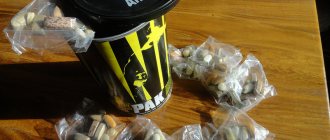On the eve of the upcoming winter holidays, more and more people are starting to think about New Year's gifts. Some people buy them in advance, others directly on New Year's Eve, but one thing remains unchanged - the presence of sweets on the festive table. And really, what would a holiday be without a chocolate gift under the tree. And below we will analyze the composition of chocolate: what is the catch here?
A box of delicious treats has long been an annual New Year's tradition. But such a seemingly harmless children's prank, like a simple chocolate bar, may not be safe at all and pose a serious threat to human health.
What products are made from chocolate? A huge variety! Even more than you can imagine: candies, bars, cookies, muffins, sherbets, pastries, ice cream, cakes, puddings, jellies, soufflés, cocktails, pastes, syrups and much more!
The main components that give the right to the entire variety of chocolate products to call themselves chocolate are cocoa mass
and
cocoa
butter
. However, few people want to use them in this form. Manufacturers add sweeteners to improve taste. So what does real chocolate consist of? Let's try to figure it out!
Composition of healthy chocolate
A high-quality real product contains:
- phenylethylamine – a hormone that saturates the brain with serotonin and improves the functioning of nerve cells;
- theobromine and magnesium, which relax nerve endings, relieve stress, and improve emotional and mental state;
- plant flavonoids that stimulate blood flow, brain nutrition, and oxygen saturation of neurons;
- antioxidants that can remove free radicals, prevent the destruction of neurons and slow down the aging process.
Cocoa beans are rich in natural substances that stimulate the production of serotonin, dopamine and tryptophan. They are responsible for energy and mood, and with their deficiency, neuroses and depression develop.
The muscle and nerve cells of our body contain lecithin, which is quickly consumed during physical and emotional stress. Your favorite treat helps replenish its reserves. It relieves irritability and fatigue.
The bitter bar contains not just one vitamin, but a whole complex - A, B, D, E, F, PP. Plus, such useful microelements as potassium, magnesium, phosphorus, calcium, zinc, iron.
Appearance
So, you have already bought chocolate. High-quality tiles are glossy and shiny. If there is a white coating on the tile, it means it was stored incorrectly. This chocolate can be eaten, but its taste is most likely impaired. Break the chocolate: it should crunch loudly and loudly, and remain matte when broken. In addition, a good quality product will almost immediately leave marks on your hands - the melting point of cocoa butter is lower than the temperature of the human body.
For the brain and blood vessels
Is chocolate good for the brain? Of course, because cardiologists even recommend replacing coffee with a treat. The sweetness contains polyphenols, which have a beneficial effect on the cardiovascular system and prevent the formation of cholesterol plaques. And a greater amount of antioxidants than in blueberries turns out to be more effective against cell aging.
A few pieces of treats a day improve the functioning of the brain, heart, and blood vessels, namely:
- increase concentration;
- protect against rapid fatigue;
- accelerate the speed at which the brain processes information and transmits it to nerve endings;
- improve the perception and assimilation of information;
- speed up thought processes and reactions;
- support short-term memory.
BY THE WAY! The delicacy increases performance and improves thought processes, which means that those who work under stressful conditions should not refuse it. But if the effect from a milk bar lasts no more than 2 hours, then from a bitter bar it lasts more than three.
Benefits for men
Reasonable consumption of chocolate is also beneficial for the stronger sex.
- Chocolate reduces the level of bad cholesterol, and therefore the risk of stroke and heart attack, to which men are often susceptible.
- This treat reduces the effects of stress and improves your mood.
- Cocoa beans can help in the fight against alcohol and tobacco addiction, as they reduce the body's need for these harmful substances.
- Dopamine contained in this product increases libido and potency.
Attention: the norm for an adult is no more than 50 g per day.
For the liver
The beneficial properties of chocolate for liver health are talked about only in relation to a bitter product, which:
- acts as an antispasmodic;
- dilates blood vessels and reduces pressure in the abdominal cavity;
- cleanses the liver;
- reduces the number of free radicals;
- increases immunity;
- reduces the risk of inflammation.
Regular consumption of sweets should not be forgotten by those who drink alcohol and also like spicy and fatty foods. A number of studies have confirmed the beneficial effects of a product with a high content of cocoa beans (more than 80%) in cirrhosis.
Ingredients: what to look for
It is known that the main components of any type of chocolate are:
- cocoa bean butter;
- grated cocoa beans;
- sugar.
In addition, various additives are used in industrial production, which can cause hidden harm to the consumer.
For example, soy lecithin is used to impart uniformity and plasticity to the finished product. It is made from inexpensive soybeans, most of which are genetically modified and can negatively affect our health.
So that the delicacy does not present you with unpleasant surprises, I advise you to carefully read its composition on the packaging and choose those brands that do not strive to reduce the cost of production and use high-quality, although perhaps more expensive, ingredients.
You can read more about how and what chocolate is made from in a separate article.
Since morning
If you don't eat chocolate in the morning on an empty stomach, it won't cause any harm.
Such a sweet breakfast:
- activates mental activity;
- gives strength and invigorates;
- produces the happiness hormone endorphin and charges you with positivity for the whole day.
Nutritionists advise eating chocolate desserts in the morning so that the nutrients are better absorbed. The calories of such a breakfast are spent during the day with energy, and are not deposited on the waist.
Myth No. 3
We think that replacing regular chocolate with organic chocolate will improve your health.
In fact : This chocolate can normalize eating behavior. For example, if a person eats regular chocolate every day, but switches to beautifully packaged chocolate with whole nuts, but every other day, this will significantly improve the “composition” of his body. That is, you can turn the consumption of such chocolate into a ritual: there will be many times more pleasure, and fewer breakdowns.
This is partly true, since private pastry chefs are usually more vigilant in selecting ingredients. But when production becomes large-scale, cheaper products are chosen so that such chocolate is competitive. Who will buy a chocolate bar for 500 rubles? But organic chocolate can cost more. Of course, few can afford this, so manufacturers replace sugar with fructose - it is a profitable option for them, but less healthy for us.
For children
Until the age of 3, children cannot be given the popular sweet, but after that it is not only possible, but also necessary, because it:
- improves brain activity thanks to serotonin;
- stimulates interest in cognitive activity and develops memory due to phenylaline;
- gives the body such useful vitamins as B1, B2 and PP;
- strengthens bones with calcium;
- saturates the brain with oxygen due to iron;
- potassium has a beneficial effect on the heart;
- soothes with copper and magnesium;
- boosts immunity with antioxidants;
- Gives energy thanks to fast carbohydrates.
A bar with a low sugar content is healthier than other sweets for children’s teeth: it does not stick to the teeth like toffee and does not stay in the mouth for a long time like candy.
Use in cosmetology
Women have found use for chocolate not only in cooking, but also in cosmetology. The fact is that cocoa butter can improve the structure of skin and hair, so even at home you can make body wraps, scrubs and masks from it.
It is enough to take a bar of this delicacy, as well as auxiliary ingredients - for example, clay or algae.
If you have dry skin, then I recommend making a chocolate mixture with egg yolk or sour cream. For oily skin, a mix with oatmeal or kefir is suitable.
Harm and contraindications
Any, even the most healthy product, if consumed unrestrained, can cause harm. Therefore, you need to remember the recommended dose - slightly less than a standard tile. On average, this is 30-50 grams - this amount will provide the required amount of vitamins, elements and nutrients and will not cause harm.
This standard is followed for dark chocolate. For milk and white - reduce by half, that is, to 15-25 grams per day.
To prevent healthy sweets from causing harm, do not exceed the recommended daily intake. Otherwise, the body will begin to produce serotonin in excess quantities, which will lead to insomnia, gluttony, irritability, and migraines.
You shouldn't treat yourself to a treat every day. Using it daily for a month can easily cause addiction, in which the body will no longer accept beneficial flavonoids.
The product is contraindicated because it suffers from such pathologies as:
- type 2 diabetes;
- nervous diseases;
- atherosclerosis;
- problems with the digestive tract and kidneys;
- increased acidity;
- individual intolerance to cocoa beans and ingredients included in the product.
IMPORTANT! In case of diabetes and high blood sugar, only after the approval of the attending physician, it is permissible to eat a small amount of a product that contains no more than 8% sugar. You can, for example, buy healthy sweets made from carob.
Myth No. 1
We think: all the ingredients in eco-chocolate are healthy.
In fact : The ginger chocolate bar contains lecithin E476. Cedar lecithin is also present in sample No. 3. There are different types of lecithin: soy, cedar, etc. The only contraindication is individual intolerance, for example, an allergy to soy or cedar.
However, lecithin E476 is still controversial among scientists. It can be used in the Russian Federation, Ukraine and many European countries, however, with excessive consumption of soy lecithin, according to some data, an enlargement of the liver and kidneys is observed.
Evaporated coconut nectar is usually added for sweetness, but it is the same sugar, just not beet sugar. It has a low glycemic index, but it does not take into account the combination of indices of all components of the chocolate bar. If the composition contains dried fruits or nuts, the glycemic index of the entire product will be much higher.
Question answer
How is cocoa different from hot chocolate?
How to choose the right healthy and tasty chocolate
A real quality product, not a cheap confectionery bar, should not contain confectionery fats other than cocoa butter. Sunflower, soybean, palm, cottonseed oil - these types of inexpensive raw materials do not make the delicacy healthy.
To choose healthy chocolate, carefully study the composition. If it contains more than 70% cocoa beans, there is no doubt that the sweetness will have a beneficial effect on the entire body. And remember: you can always choose healthy natural chocolate from the assortment of the Fidelity to Quality factory.
Calorie content of bitter (black), milk and white chocolate
Chocolate is not only tasty, but also a fairly high-calorie product that quickly saturates the body with energy.
Calorie content of dark chocolate – 518 Kcal.
Calorie content of milk chocolate – 536 Kcal.
Calorie content of white chocolate – 554 Kcal.
On a note! The average values for the calorie content of chocolate are given - depending on the origin (brand of delicacy) used to make the standards, and the presence of additives in the product, the value may differ. In other words, the calorie content of identical chocolate bars may vary slightly between brands.
Lecithin: to be afraid of it or not?
Many chocolate products contain lecithin. But even if you find it in your favorite bar or candy, don’t panic. This emulsifier is used to give chocolate homogeneity. It is thanks to him that there are no lumps or films on the chocolate bar. The result is a chocolate bar of a beautiful, uniform color.
In short, if you want to buy really good dark chocolate, pay attention to the fine print on the label. Read the composition. See if there is a GOST mark on the wrapper or not.
We quickly determine the quality of the product
How to determine the quality of chocolate in just a few seconds?
- We look at the composition (the ratio of ingredients, whether there is anything superfluous).
- Shelf life – up to 6 months.
- The surface is smooth, beautiful and shiny.
- When breaking, a characteristic crunch is heard.
- Melts in your mouth gradually.
The desire to understand what real chocolate should be like is understandable. The natural product is very useful. Of course, if you don't abuse it. And cheap ingredient substitutes are unlikely to provide health benefits.
Dosage
For an adult, the daily intake of dessert is about 50 g , the maximum dosage should not exceed more than 100 g of product. For children and teenagers, 20-40 g of dessert per day is enough. The lethal dose of chocolate per 1 kg of weight is about 150-200 g. With an average weight of 60 kg, you can die after eating 9-10 kg of the product.
Is it possible for a cough?
The chocolate bar helps relieve dry and wet coughs thanks to the high theobromine content in cocoa powder. The chemical has a sedative effect on the sensory neurons of the vagus nerve that innervate the mucous membranes of the upper and lower respiratory tract. Thanks to this action, the sore throat disappears and the person coughs less.
The theanine contained in the product has an antibacterial effect, improves mucus production and has an expectorant effect. To get maximum results, you need to slowly dissolve the dark chocolate on your tongue. For children, it is recommended to buy a milk or dark variety of sweets containing up to 50% cocoa powder.
Attention!
Magnesium in the tile strengthens the immune system and increases the functional activity of leukocytes. A person gets rid of cough for 3-4 hours after eating 100 g of dark chocolate.
In another article you will learn about the use of this sweet cough product.
Allergy
An allergic reaction to chocolate occurs when more than 100 g of the product is consumed every day. Itching and rashes can occur in both adults and children.
Allergies can be caused not only by the natural ingredients that make up the tile, but also by substitute products:
- Palm oil;
- powdered sugar;
- Coconut oil;
- peanut butter;
- various additives: dried fruits, raisins, cookies.
In adults
With regular use of large amounts of dessert, adults with diathesis may develop the following allergy symptoms:
- nasal congestion;
- sore throat;
- dry cough;
- lacrimation;
- runny nose, allergic rhinitis;
- hives;
- dry skin;
- itching and rashes.
Advice
If the allergy was caused by the use of milk protein contained in milk chocolate, nausea, vomiting and stomach pain may develop.
In children
The child's body has a fragile immune system. When a large amount of sweets is consumed, the child’s blood sugar level rises sharply. As a result, the activity of leukocytes increases. When potential allergens are detected: phenylethylamine, organic acids, theobromine, immunocompetent cells begin to attack them.
These substances enter the blood through the intestines when the dessert is digested (is chocolate digested quickly in the stomach?). As a result, a negative reaction of the body occurs:
- rashes;
- increased lacrimation;
- discharge of clear fluid from the nose;
- severe itching of the skin;
- the occurrence of acne;
- intestinal dysfunction;
- angioedema.
Allergies in infants can be caused by exposure to potential allergens through mother's milk. We have prepared a separate article for you in which you will learn all the details about the diagnosis and treatment of chocolate allergies in children.
What happens if you eat expired?
It is not recommended to eat tiles that have been in storage for more than 6 months from the date of release. In expired chocolate, fat oxidation occurs. As a result of the chemical reaction, various carcinogens begin to be released, which, when entering the body, increase the risk of cancerous degeneration of cells.
Toxins can lead to dyspeptic disorders:
- nausea;
- diarrhea;
- vomiting;
- your stomach may hurt;
- increased gas formation in the intestines;
- flatulence.
It is strictly forbidden to eat a product with an unpleasant smell of mold, or tiles that taste like rancid oil.
A white coating on the tile is not always a sign of an expired product. Cloudy drops on the surface of the dessert are drops of protruding cocoa butter.
Russian chocolate factories
The best Russian chocolate is made at several factories of the United Confectioner holding:
- "Red October".
- "Rot Front".
- Concern "Babaevsky".
The products of the latter concern amaze with their variety of flavor solutions. Chocolate with various additives is produced here: ginger, candied fruits, nuts, sesame seeds, vitamins. In the production of some varieties of delicacy, sugar substitutes are used. Dark chocolate, which does not contain any impurities or additives, contains 75-87% cocoa mass.
Concern "Red October" produces delicacies of the famous brand "Slava". The product is available in regular and porous form. This chocolate contains about 80% cocoa liquor.
The Rot Front factory produces three versions of the delicacy called “Autumn Waltz”, which contains 56% cocoa liquor, as well as:
- Alcohol.
- Orange pieces.
- Orange slices and alcohol.
Is it true what they say on the packaging?
Let's say you bought sugar-free dark chocolate that says 86% cocoa on the cover. But should you trust the manufacturer? Or is this just a publicity stunt?
According to experts, what is written does not always correspond to reality. When looking at the percentage of cocoa content, you should take into account its solids. This indicator is also indicated on the label, but is lost against the backdrop of bright and attractive product data. For example, by carefully examining the wrapper of Pobeda 72% sugar-free dark chocolate (indicated in large print on the label), you can see that the real percentage of cocoa is 69.1%. The total difference in the real and advertising ratio is 2.9%.
Elite chocolate from France
France also produces delicious and high-quality chocolate. Gradually, chocolate producers in this country are displacing producers from Belgium and Switzerland. It is worth noting that the French delicacy surprises not only with its unique taste, but also with its combination of products. Some manufacturers equip packages with candies and chocolate bars with special sensors that maintain optimal temperature conditions and air humidity. This allows you to preserve the treat. Among the popular French brands we should highlight:
- "Michelle Richard."
- "Madame Sevigne"
- "Michel Chatillon."
Taste qualities of chocolate
If we talk about the taste of the Pobeda chocolate bar, it differs little from ordinary chocolate with sugar. Yes, there is a pronounced bitterness in it, and, according to consumers, this taste can be felt at the first bite and while chewing a chocolate slice. Later you can catch a pleasant sweetish aftertaste.
In a word, most fans of dark dark chocolate give Pobeda a solid four. As you understand, one point is reduced for a small deception with the percentage of cocoa.
Chemical composition of real chocolate product
Good, natural chocolate has 3 main components: cocoa powder, cocoa butter and powdered sugar. This is the chemical formula of a quality product. The structure of the tile can be supplemented with milk powder, dyes, flavors and substitute products. The latter include fructose, which replaces sugar in a product for diabetics, and palm oil. The latter replaces cocoa butter.
The sweet also contains the following nutrients:
- Saturated, mono- and polyunsaturated fatty acids, omega-3 and omega-6.
- Vitamins:
- A.
- B.
- C.
- D.
- E.
- K.
- Mineral components:
- iron;
- fluorine;
- potassium;
- calcium;
- sodium;
- zinc;
- manganese;
- selenium.
- Phytosterols.
- Cholesterol.
- Theobromine.
- Phenylethylamine.
- Flavonoids.
- Plant fibers.
As an emulsifier, the composition of the bar can be supplemented with soy lecithin (you will learn about the emulsifier E322 and E476 in chocolate here). The chemical thickens the chocolate and prevents it from melting at high temperatures. It does not harm the body, as it consists of a number of plant fatty acids. Soy lecithin is freely broken down by hydrochloric acid and absorbed by the body.
Important!
Some manufacturers add alcoholic beverages to chocolate: cognac, liqueur, rum, wine. As a result, the chemical structure of the product is supplemented with ethyl alcohol.
It has a relaxing effect on the body and does not harm the health of an adult, as it is contained in small quantities. Ethanol is easily destroyed in liver cells within an hour after entering the blood.
Now you know what the confectionery product consists of.
Nutritional value of dairy
Calorie content per 100 grams of product is 535 kcal, 1 slice - 35.6 kcal . How many carbohydrates, fats and proteins are in the product:
- 59.4 g carbohydrates;
- 29 g fat;
- 7.65 g protein.
In addition to cocoa powder, powdered sugar and cocoa butter, milk powder is added to the product.
Gorky
The bitter variety of chocolate has the highest content of cocoa beans - from 70 to 90% of the total composition. The energy value of 100 g of dessert is about 544 kcal, 1 slice - 36.1 kcal.
Per 100 g of product there are:
- 8.2 g protein;
- 44.6 g carbohydrates;
- 37.1 g fat.
Dark
The dark variety contains up to 70% cocoa powder. This is how many calories there are per 100 g of chocolate – 540-590 kcal, and in 1 slice – up to 37 kcal.
The nutritional value of the dark variety is:
- 42 g fat;
- 8 g proteins;
- 45.9 g carbohydrates.
Learn more about the composition of dark and dark chocolate, as well as its benefits and contraindications, separately.
White
White chocolate does not contain ground cocoa beans. It contains only vegetable oil and powdered sugar. The energy value per 100 g is 539 kcal, which forms:
- 5.87 g protein;
- 32 g fat;
- 59.4 g carbohydrates.
But how many calories are in one slice of the product – 35.9 kcal.
Find out if you can eat white chocolate while breastfeeding.
Hot
The calorie content of 100 ml of hot chocolate is 77 kcal. The low energy value is due to the fact that the structure of such a product consists of only 20% natural cocoa powder. 80% of the drink comes from water, starch and other compounds.
Which one has the least calories?
The dairy variety has the lowest energy value - 535 kcal per 100 g of product. It contains up to 50% cocoa powder, a small amount of powdered sugar, dry cream and up to 20% cocoa butter. Unlike other types of chocolate, it does not contain a lot of coarse fiber, glucose and vegetable oil.
Which one is the most useful?
Dark chocolate, which contains up to 90% natural cocoa powder, is considered the most healthy. Other products contain foreign ingredients:
- powdered sugar;
- heavy dry cream;
- flavorings and dyes.
Attention!
Dark chocolate activates metabolism, improves the functioning of internal organs, and stabilizes hormonal levels.











